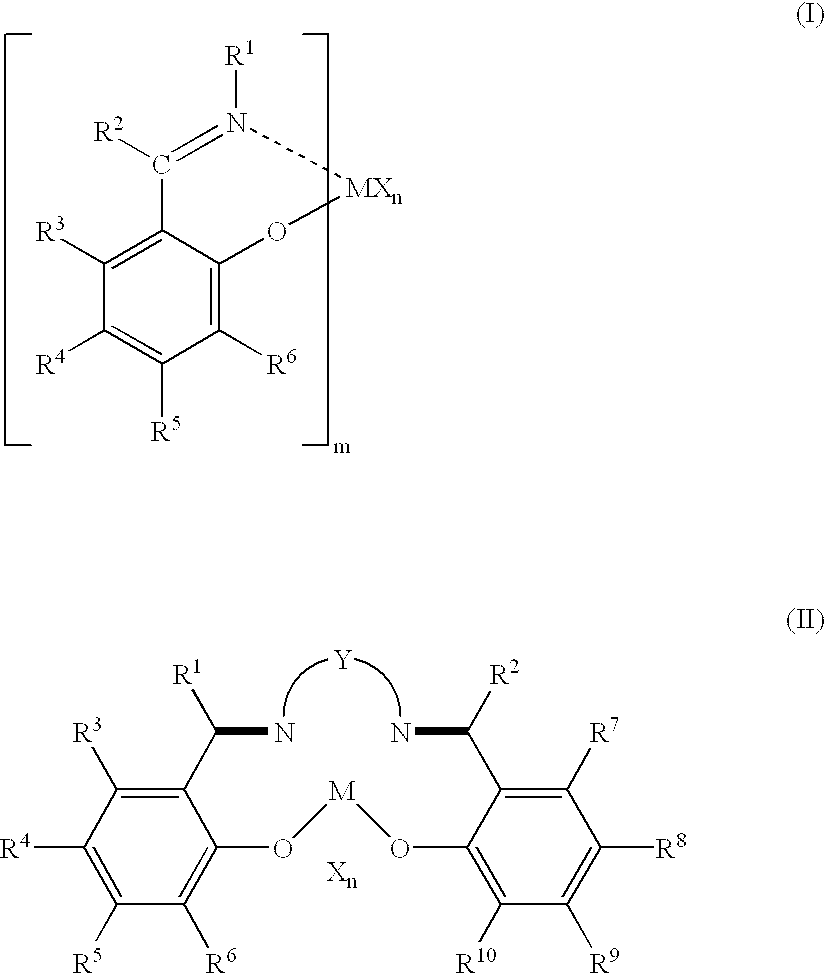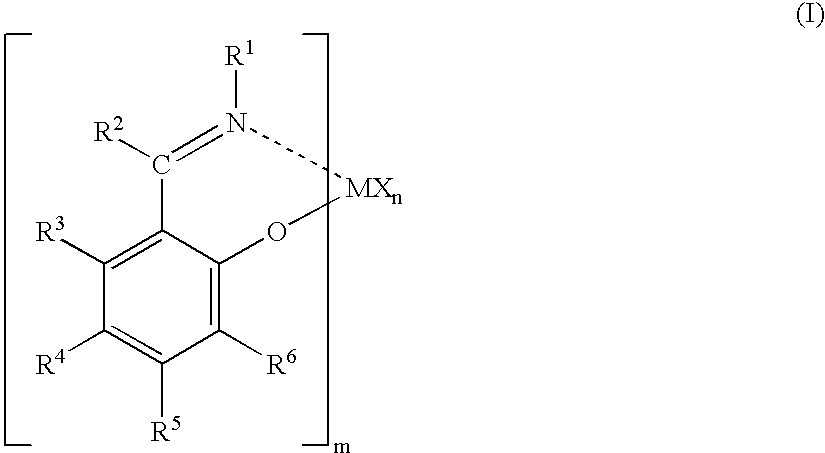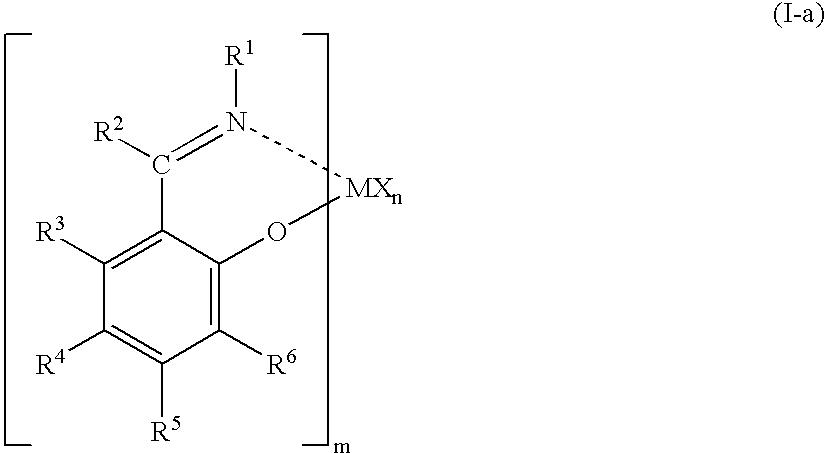Olefin polymerization catalysts, transition metal compounds, processes for olefin polymerization, and alpha-olefin/conjugated diene copolymers
a technology of conjugated diene and polymerization catalyst, which is applied in the direction of catalyst activation/preparation, chemical/physical processes, and group 5/15 element organic compounds, can solve the problems of low reactivity, low activity, and high cost of non-conjugated dienes used in copolymerization, and achieve excellent olefin polymerization activities
- Summary
- Abstract
- Description
- Claims
- Application Information
AI Technical Summary
Benefits of technology
Problems solved by technology
Method used
Image
Examples
synthesis example 1
Ligand Synthesis Example 1
[0581] Synthesis of Ligand (L1)
[0582] To a 100 ml reactor thoroughly purged with nitrogen, 40 ml of ethanol, 0.71 g (7.62 mmol) of aniline and 1.35 g (7.58 mmol) of 3-t-butylsalicylaldehyde were introduced, and they were stirred at room temperature for 24 hours. The reaction solution was concentrated under reduced pressure to remove the solvent. Then, 40 ml of ethanol was added again, and the mixture was stirred at room temperature for 12 hours. The reaction solution was concentrated under reduced pressure to obtain 1.83 g (7.23 mmol, yield: 95%) of a compound represented by the following formula (L1) as an orange oil. 36
[0583] .sup.1H-NMR (CDCl.sub.3): 1.47 (s, 9H), 6.88 (dd, 1H), 7.24-7.31 (m, 4H), 7.38-7.46 (m, 3H), 8.64 (s, 1H), 13.95 (s, 1H) IR (neat): 1575, 1590, 1610 cm.sup.-1 FD-mass spectrometry: 253
Ligand Synthesis Example 2
[0584] Synthesis of Ligand (L2)
[0585] To a 100 ml reactor thoroughly purged with nitrogen, 30 ml of ethanol, 1.34 g (9.99 mmo...
synthesis examples 4-42
Ligand Synthesis Examples 4-42
[0590] Ligands L4 to L42 were synthesized in the similar manner as in the forgoing Ligand Synthesis Examples.
[0591] The identification of their structures were made by .sup.1H-NMR and FD-mass spectrometry. 39
[0592] Specific syntheses of transition metal compounds according to the present invention are given below.
[0593] Synthesis of Compound A-1
[0594] To a 300 ml reactor thoroughly dried and purged with argon, 1.785 g (7.05 mmol) of compound L1 and 100 ml of diethyl ether were introduced, and they were cooled to -78.degree. C. and stirred. After 4.78 ml of n-butyllithium (1.55 mmol / ml n-hexane solution, 7.40 mmol) was dropwise added over a period of 5 minutes, the temperature was slowly raised to room temperature, and stirring was continued for 4 hours at room temperature to prepare a lithium salt solution. The solution was slowly dropwise added to a mixture of 7.05 ml of a titanium tetrachloride solution (0.5 mmol / ml heptane solution, 3.53 mmol) and 40...
synthesis example 2
[0600] Synthesis of Compound B-1
[0601] To a 200 ml reactor thoroughly dried and purged with argon, 1.53 g (6.04 mmol) of compound L1 and 60 ml of tetrahydrofuran were introduced, and they were cooled to -78.degree. C and stirred. After 4.1 ml of n-butyllithium (1.55 mmol / ml n-hexane solution, 6.34 mmol) was dropwise added over a period of 5 minutes, the temperature was slowly raised to room temperature, and stirring was continued at room temperature for 4 hours. To the reaction solution was added 10 ml of tetrahydrofuran, and the mixture was slowly added to a solution of 0.70 g of zirconium tetrachloride (purity: 99.9%, 3.02 mmol) in 30 ml of tetrahydrofuran which had been cooled to -78.degree. C. After the addition, the temperature was slowly raised to room temperature. The reaction solution was stirred for 2 hours at room temperature and then further stirred for another 4 hours under reflux.
[0602] The reaction solution was concentrated under reduced pressure, and the solid precipi...
PUM
| Property | Measurement | Unit |
|---|---|---|
| molecular weight distribution | aaaaa | aaaaa |
| temperature | aaaaa | aaaaa |
| specific surface area | aaaaa | aaaaa |
Abstract
Description
Claims
Application Information
 Login to View More
Login to View More - R&D
- Intellectual Property
- Life Sciences
- Materials
- Tech Scout
- Unparalleled Data Quality
- Higher Quality Content
- 60% Fewer Hallucinations
Browse by: Latest US Patents, China's latest patents, Technical Efficacy Thesaurus, Application Domain, Technology Topic, Popular Technical Reports.
© 2025 PatSnap. All rights reserved.Legal|Privacy policy|Modern Slavery Act Transparency Statement|Sitemap|About US| Contact US: help@patsnap.com



